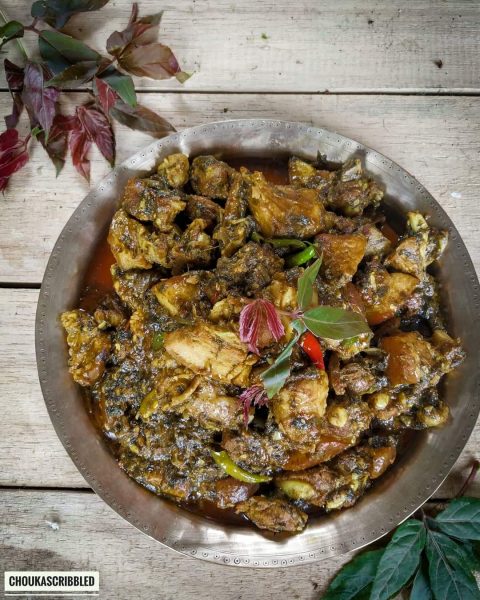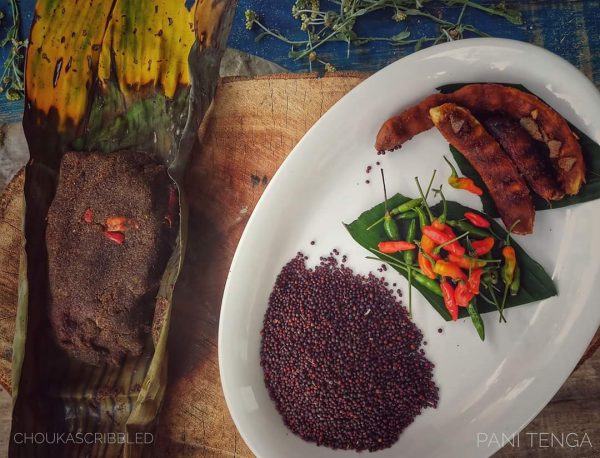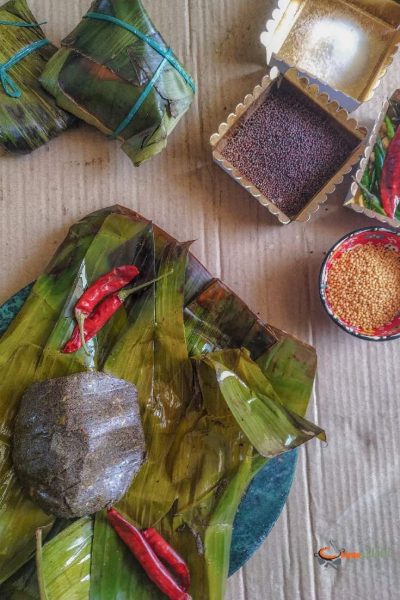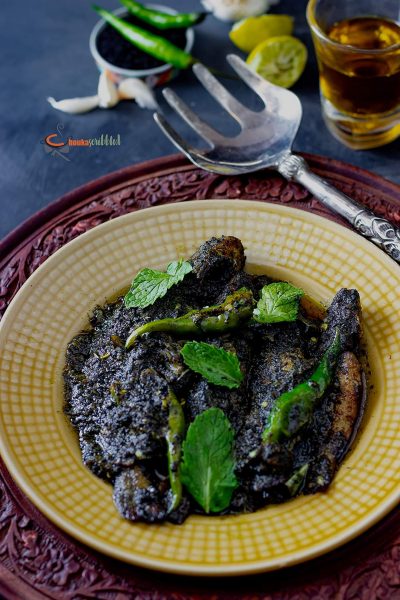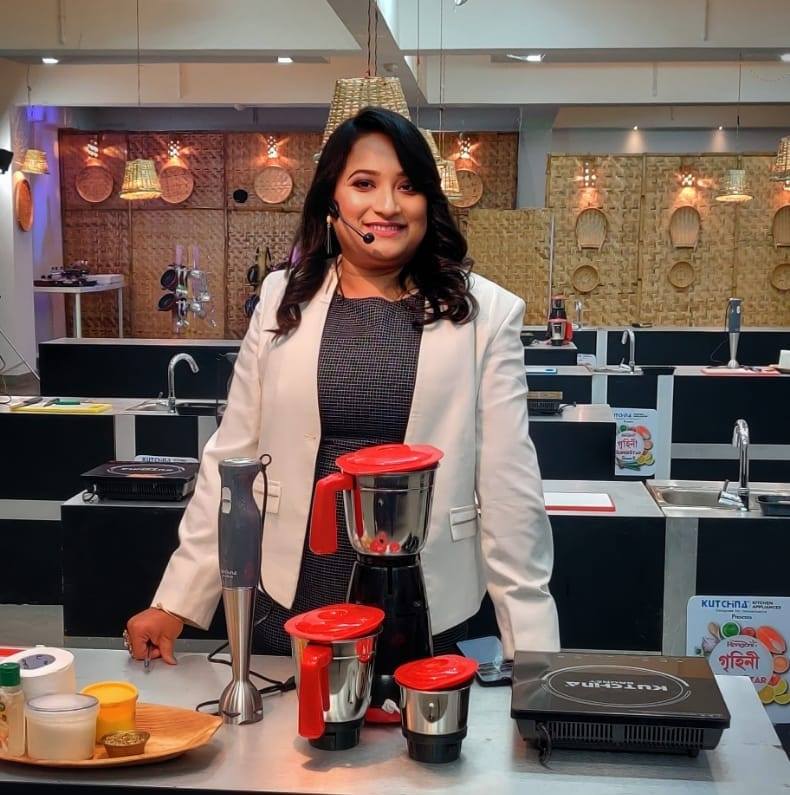Assamese Regional Recipes
April 28, 2020
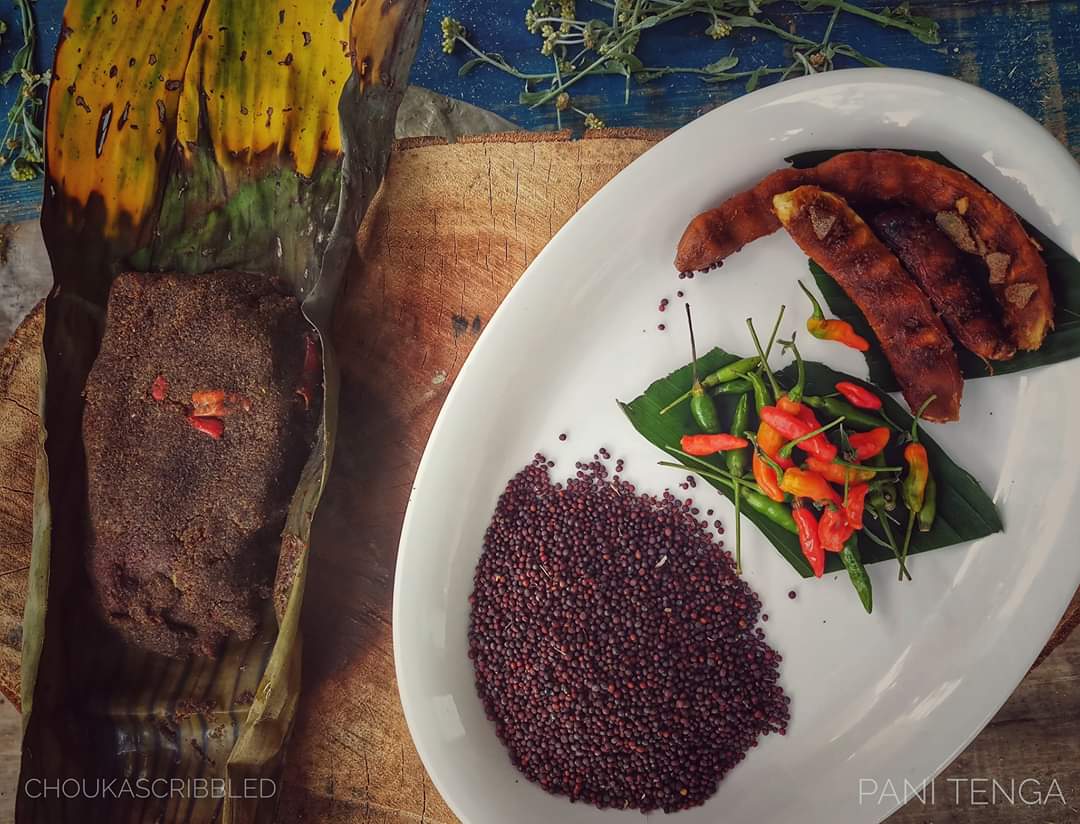
.
The popularity of Nol Tenga in Upper Assam vis-à-vis its almost complete absence in the lower Assam cuisine is one example of the zonal culinary differences of Assam. The same can also be said about the varieties of rice in different parts of Assam.I love cooking pork in nol-tenga as it makes a dish that is spicy and tangy at the same time. I would recommend you to not add too much water so the gravy has a thick consistency – only use as much water as you need to bind the ingredients together.Yield – serves 4.
Prep Time 10 Minutes
Cook Time 40 Minutes
Onions 1 large Finely sliced
Ginger Garlic paste 1 tablespoon
Salt to taste
Nal Tenga/Gongura 2 Handfuls
Green Chillies 10-12 Slit
Ginger Grated 1tbsp
Salt to taste
2. Sift the pork and salt to the wok and roast in medium heat until
it liberates enough fat to fry the remaining ingredients.
3. Once enough fat has been rendered out, add onions, followed by
pounded ginger garlic.
4. Add water when needed to avoid the spices from getting stuck to
the bottom of the wok.
5. When the pork is almost done, add the nol tenga and slit green chillies.
6. When the Nol Tenga has turned mushy, and you see oil emerging on the sides, add half a cup of water and grated ginger.
Panitenga
Panitenga is a fermented mash of black mustard and mustard greens seeds with a souring agent, typically mangosteen pulp , tarmarind pulp or lime juice. This mixtures forms an quintessential part of an Assamese platter.
I still vividly remember the first time I had panitenga. Me being me, and generally unaware of the portion size that is supposed to be had, put half a teaspoon in my mouth at one go.What I distinctly remember is that first whiff, which in itself was so overwhelming but at the same time so strongly tantalised my sense of smell and sight, leaving me unable to make out what just dived into my eyes and nose.
It is stimulating and invigorating properties would definitely open up your senses, making them ready to relish a scrumptious meal to the fullest.
The pungency of the Panitenga is also known to remove nasal congestion, clear sinuses and kindle the digestive fire.
Prep Time 10 mins
Passive Time for fermenting 4 days
Yield – serves 10 people
INGREDIENTS
150 gms black mustard seed washed and dried, Kola Horihoh
50 cup gms mustard green seed lai xaak’r guti
1/2 cup mango steen pulp or tamarind pulp thekera, teteli
Dried chilly optional
Salt
Banana leaf – cut to similar size as an A4 sheet of paper
METHOD
Using a mortar and pestle, pound both the types of seed into a fine powder. You can definitely go with a mechanical grinder, but some traditional recipes tastes the best when made the traditional way. Transfer the powdered mix to a bowl.
Add mangosteen / tarmarind pulp, chillies and salt.
Knead everything gently to make dough.
Heat the banana leaves carefully on low flame (similar to roasting pappad) to make it malleable.
Wrap the dough with the banana leaves to make a nice parcel. Secure it properly with a piece of string.
Keep the parcel inside a clean container in a warm place for 3 or 4 days.
How to serve:
You may serve the pani tenga as an acompaniment to your regular meal, or add to other dishes .
Kala Jeera Masor (Nigella Fish Curry)
This is a recipe celebrated in the lower parts of Assam. When I had this fragrant spicy fish curry for the first time, it came across as a soothing breeze of fresh air. As an Assamese, I now have one more unique recipe to happily brag about.
Assamese fish curries/ Masor jhul are not just based on Tenga, Mustard paste, Khar, Herbs and vegetables, but also on some really bold and beautiful spices!!!!!
Nigella seeds/ kalajeera as a base in Fish curry is not something that my family has grown up eating in upper Assam where the use of Nigella seeds has always been confined to a tarka or added as an taste enhancer in certain snacks. The geographical division of Assam into lower, middle and upper parts somehow brought in strong culinary implications.
A stark difference in the dialect, rituals, traditions and eating habits is easily visible amongst these regions . However with progressive times of social media influence we tend to see a beautiful exchange or confluence of various culinary traditions. Pork, which has always been integral to tribal cuisine was deeply abhorred by so many non tribal communities till the past decade. But now, the tables have turned and guess what, ask any millennial about their favorite meat, 8/10 would give a cheer for pork!
Coming to the recipe, it’s usually had with climbing perch/kawoi maas for its beautiful earthy flavor and soft meat. Since I couldn’t find it here in Ahmedabad, I went with Mystus Tengara/ tengra/ hingora and it tasted really good. The original recipe also goes without lime juice and green chillies, but I decided to add it for extra flavor.
The earthiness of Nigella, the heat of Black pepper, the pungency of Mustard oil with a subtle undertone of sour lime all blended together to create this beautiful healthy easy fish curry.
Course Main Dish
Cuisine Assamese
Prep Time 5 mins
Cook Time 20 mins
Yield – serves 4 people
INGREDIENTS
Fish 350gms
Nigella Seeds 3tbsp
Black pepper 1/2 tbsp
Garlic 1 regular bulb whole
Green Chillies 4 slit
Salt to taste
Lemon Juice 2 tbsp
Mustard Oil enough to shallow fry the fish and additional 2 tbsp
Turmeric 1 tbsp
Mint Leaves for Garnish
METHOD
Marinate the fish with salt and turmeric.
Make a smooth paste of Nigella seeds, garlic and black pepper. Make sure there are no grains that are left coarse grains in the paste. Shallow fry the fish in mustard oil till half done. Add 2 tbsp oil to the same pan.
Add the paste and let it cook for around 3-5 mins on medium heat.
Add half a cup of warm water and let it simmer.
Add the fish and cook till you have the desired consistency.
Add Lime juice and cook for a min or so.
Garnish with mint leaves and serve hot.
Hot tip – You can also add 1 par boiled potato for the curry to have a
thick consistency.
